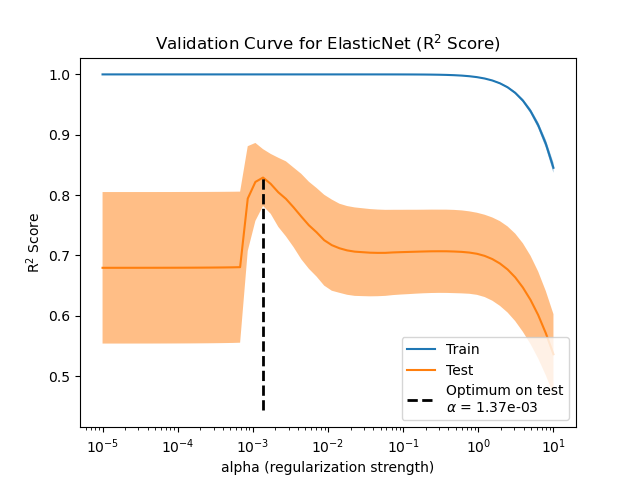Example: Train error vs Test error
Train error vs Test error
Illustration of how the performance of an estimator on unseen data (test data) is not the same as the performance on training data. As the regularization increases the performance on train decreases while the performance on test is optimal within a range of values of the regularization parameter. The example with an Elastic-Net regression model and the performance is measured using the explained variance a.k.a. R^2.
print(__doc__) # Author: Alexandre Gramfort <alexandre.gramfort@inria.fr> # License: BSD 3 clause import numpy as np from sklearn import linear_model
Generate sample data
n_samples_train, n_samples_test, n_features = 75, 150, 500 np.random.seed(0) coef = np.random.randn(n_features) coef[50:] = 0.0 # only the top 10 features are impacting the model X = np.random.randn(n_samples_train + n_samples_test, n_features) y = np.dot(X, coef) # Split train and test data X_train, X_test = X[:n_samples_train], X[n_samples_train:] y_train, y_test = y[:n_samples_train], y[n_samples_train:]
Compute train and test errors
alphas = np.logspace(-5, 1, 60)
enet = linear_model.ElasticNet(l1_ratio=0.7)
train_errors = list()
test_errors = list()
for alpha in alphas:
enet.set_params(alpha=alpha)
enet.fit(X_train, y_train)
train_errors.append(enet.score(X_train, y_train))
test_errors.append(enet.score(X_test, y_test))
i_alpha_optim = np.argmax(test_errors)
alpha_optim = alphas[i_alpha_optim]
print("Optimal regularization parameter : %s" % alpha_optim)
# Estimate the coef_ on full data with optimal regularization parameter
enet.set_params(alpha=alpha_optim)
coef_ = enet.fit(X, y).coef_
Out:
Optimal regularization parameter : 0.000335292414925
Plot results functions
import matplotlib.pyplot as plt
plt.subplot(2, 1, 1)
plt.semilogx(alphas, train_errors, label='Train')
plt.semilogx(alphas, test_errors, label='Test')
plt.vlines(alpha_optim, plt.ylim()[0], np.max(test_errors), color='k',
linewidth=3, label='Optimum on test')
plt.legend(loc='lower left')
plt.ylim([0, 1.2])
plt.xlabel('Regularization parameter')
plt.ylabel('Performance')
# Show estimated coef_ vs true coef
plt.subplot(2, 1, 2)
plt.plot(coef, label='True coef')
plt.plot(coef_, label='Estimated coef')
plt.legend()
plt.subplots_adjust(0.09, 0.04, 0.94, 0.94, 0.26, 0.26)
plt.show()

Total running time of the script: (0 minutes 2.684 seconds)
plot_train_error_vs_test_error.py
plot_train_error_vs_test_error.ipynb
© 2007–2016 The scikit-learn developers
Licensed under the 3-clause BSD License.
http://scikit-learn.org/stable/auto_examples/model_selection/plot_train_error_vs_test_error.html



